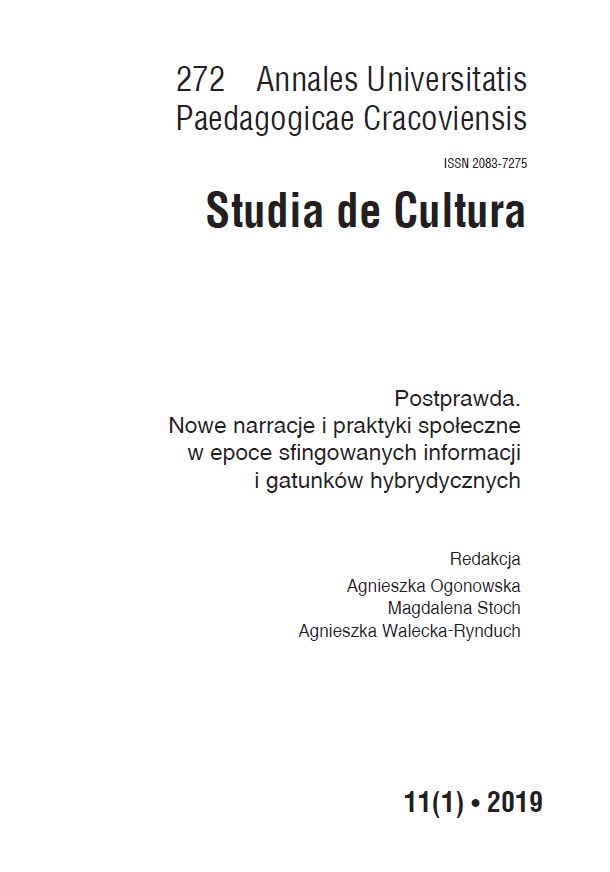Abstract
The article is an introduction to the critical analysis of media messages in the times of post-truth politics. In the first part we can find basic informations about fake news, and their distinction into their two main types: disinformation and misinformation. In the next chapter, the Author focuses on describing the contemporary media context. We find here a reference to the work of Jean Baudrillard and his theory of replacing the truth with its simulation. The article closes recommendations for media users who want to develop their media competences.
References
Allcota Hunt, Gentzkow Matthew. 2017. „Social Media and Fake Newsa in the 2016 Election”. Journal of Economic Perspectives nr 2. 211-236.
d’Ancona Matthew. 2018. Postprawda. M. Sutowski (przeł.). Warszawa.
Czubkowska Sylwia, Wątor Jakub. 2018. „Dlaczego cały świat cofa lajki Markowi Zuckerbergerowi”. Gazeta Wyborcza 6.04.2018. 12.
Baudrillard Jean. 2005. Symulakry i symulacja. S. Królak (przeł.). Warszawa.
English Oxford Living Dictionary. https://en.oxforddictionaries.com/definition/posttruth [dostęp: 4.12.2018].
European Commission. 2018. „Summary report of the public consultation on fake news and online disinformation”. https://ec.europa.eu/digital-single-market/en/news/summary-report-public-consultation-fake-news-and-online-disinformation [dostęp: 4.12.2018].
Hochschild Arlie Russell. 2017. Obcy we własnym kraju. H. Pustuła (przeł.). Warszawa.
Keyes Ralph. 2017. Czas postprawdy. Nieszczerość i oszustwa w codziennym życiu. P. Tomanek (przeł.). Warszawa.
Peters Michael A. 2017. „Education in a post-truth world”. Educational Philosophy and Theory nr 49. doi: 10.1080/00131857.2016.1264114. 564-566.
Post-truth (hasło). W English Oxford Living Dictionary. https://en.oxforddictionaries.com/definition/post-truth [dostęp: 4.12.2018].
Rehm Georg, Declerck Thierry. 2018. An Infrastructure for Empowering Internet Users to Handle Fake News and Other Online Media Phenomena. W Language Technologies for the Challenges of the Digital Age. Berlin. 216-231.
Reichardt Adam. 2018, „Era manipulacji”. Pismo nr 3.
Rosling Hans. 2018. Factfulness. Dlaczego świat jest lepszy, niż myślimy, czyli jak stereotypy zastąpić realną wiedzą. M. Popławska (przeł.). Poznań.
Silverman Craig, Singer-Vine Jeremy. 2016. The True Story Behind The Biggest Fake News Hit Of The Election. https://www.buzzfeednews.com/article/craigsilverman/thestrangest-fake-news-empire [dostęp: 4.12.2018].
Snopes. com. https://www.snopes.com/ [dostęp: 4.12.2018].
Standardy mówienia i pisania o migrantach i migrantkach w mediach. 2015. http://www.ekspert.info-migrator.pl/images/Plik_do_pobrania/ekspert/Standardy%20%C%B3wienia%20i%20pisania%20o%20migrantach%20i%20migrantkach%20w%20mediach.pdf [dostęp: 4.12.2018].
Urzędowska Marta. 2018. „Antysemityzm w Europie «żywy i silny»”. Gazeta Wyborcza nr 277. 8.
„World Press Freedom Index”. 2019. https://rsf.org/en/ranking_table [dostęp: 4.12.2018].

